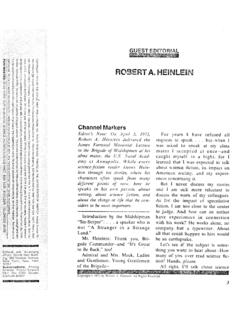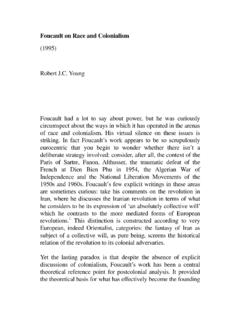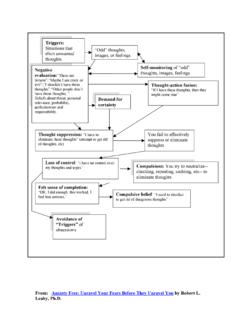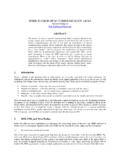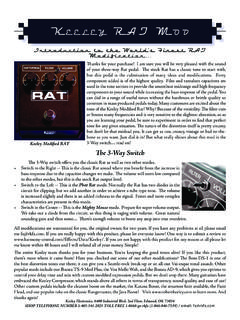Transcription of Moisture-sensitive Components - TOTECH GLOBAL
1 Moisture-sensitive Components robert Rowland The topic of Moisture-sensitive Components is rather boring but very important and frequently misunderstood. Increased Moisture-sensitive component use, such as thin fine-pitch devices and ball grid arrays (BGA), has increased concern for this failure mechanism. When Components are exposed to the elevated temperatures that occur during reflow soldering, moisture trapped inside plastic surface mount devices (SMD) produces enough vapor pressure to damage or destroy the device. Common failure modes include internal separation (delamination) of the plastic from the die or lead-frame; wire bond damage; die damage; and internal cracks that do not extend to the component surface. In extreme cases, cracks will extend to the component surface; in the most severe cases, the component will bulge and pop (referred to as the "popcorn" effect). The IPC Association Connecting Electronic Industries created and released IPC-M-109, Moisture-sensitive component Standards and Guideline Manual.
2 It includes the following seven documents: IPC/JEDEC J-STD-020, moisture /Reflow Sensitivity Classification for Plastic Integrated Circuit (IC) SMDs IPC/JEDEC J-STD-033, Standard for Handling, Packing, Shipping and Use of moisture Reflow sensitive SMDs IPC/JEDEC J-STD-035, Acoustic Microscopy for Non-hermetic Encapsulated Electronic Components IPC-9501, PWB Assembly Pro- cess Simulation for Evaluation of Electronic Components (Preconditioning IC Components ) IPC-9502, PWB Assembly Soldering Process Guideline for Electronic Components IPC-9503, moisture Sensitivity Classification for Non-IC Components IPC-9504, Assembly Process Simulation for Evaluation of Non-IC Components (Preconditioning Non-IC Components ). The original Moisture-sensitive component document, IPC-SM-786, Procedures for Characterizing and Handling of moisture /Reflow sensitive ICs, no longer is active. IPC/JEDEC J-STD-020 defines the classification procedure for Moisture-sensitive Components , , non-hermetic packages made from moisture -permeable materials such as plastic.
3 The process includes exposure to reflow soldering temperatures followed by detailed visual inspection, scanning acoustic microscopy, cross-sectioning and electrical testing. Test results are based on component body temperature, because the plastic molding is the main concern. The standard reflow temperature is 220 C +5 /-0 C, but reflow experiments discovered that small volume Components reach temperatures as high as 235 C when the board is temperature profiled for large-volume Components . When the higher temperature is a possibility, as would be the case on boards that contain both small- and large-volume Components , a reflow temperature of 235 C is recommended for the evaluation. Convection-dominant, infrared (IR)-dominant or vapor-phase reflow equipment can be used, as long as it can achieve the desired reflow profile according to J-STD-020. The eight moisture classification levels and floor life are listed below. For details regarding soak time criteria, reference J-STD-020. Level 1 unlimited floor life at less than or equal to 30 C/85 percent RH Level 2 one year floor life at less than or equal to 30 C/60 percent RH Level 2a four week floor life at less than or equal to 30 C/60 percent RH Level 3 168 hour floor life at less than or equal to 30 C/60 percent RH Level 4 72 hour floor life at less than or equal to 30 C/60 percent RH Level 5 48 hour floor life at less than or equal to 30 C/60 percent RH Level 5a 24 hour floor life at less than or equal to 30 C/60 percent RH Level 6 time on label floor life at less than or equal to 30 C/60 percent RH.
4 (For level 6, the Components must be baked before use and reflowed within the time limit specified on the Moisture-sensitive caution label.) Weight-gain analysis (reference J-STD-020) establishes an estimated floor life, and weight-loss analysis establishes the bake time required to remove excess component moisture . J-STD-033 provides detailed information regarding bake temperature and time. IPC/JEDEC J-STD-033 provides recommendations for handling, packing, shipping and baking Moisture-sensitive Components . The emphasis is on packaging and preventing moisture absorption baking or desiccation should be used as a last resort after excessive exposure has occurred. Dry packing involves sealing Moisture-sensitive Components in moisture -barrier bags with desiccant, a humidity indicator card and Moisture-sensitive caution labels. The labels contain information regarding shelf life at specific temperature and humidity ranges, peak package body temperature (220 or 235 C), exposure time after bag is opened, details about when baking is required, the baking procedure, and the bag seal date.
5 Level 1. Drying before bagging is optional, bagging and desiccant are optional, and labeling is not required unless the Components are classified at the 235 C reflow temperature. Level 2. Drying before bagging is optional, bagging and desiccant are required, and labeling is required. Levels 2a through 5a. Drying before bagging is required, bagging and desiccant are required, and labeling is required. Level 6. Drying before bagging is optional, bagging and desiccant are optional, and labeling is required. component drying uses one of two methods: desiccation or baking. Room-temperature desiccation, an option for Components that were exposed for less than 8 hours to conditions not exceeding 30 C and 60 percent RH, uses standard dry-pack methods or a dry box capable of maintaining 25 5 C with less than 10 percent RH. Baking is a bit more complicated than many people realize. There are baking recommendations for pre- and post-dry pack based on level and package thickness. Pre-baking is used to prepare Components for dry packing, while post-baking is used to recondition Components after floor life expiration.
6 Review and follow the time/temperature recommendations for baking in J-STD-033. Baking temperatures can decrease lead solderability by oxidizing the leads or causing excessive intermetallic growth. Do not store Components in an oven at baking temperature. Remember, high-temperature trays can be baked at 125 C, while low-temperature trays cannot be baked at temperatures higher than 40 C. IPC pre-bake recommendations prior to dry pack are: Package thickness less than or equal to mm: For levels 2a through 5a, bake time ranges from 8 to 28 hours at 125 C, or 4 to 14 hours at 150 C. Package thickness less than or equal to mm: For levels 2a through 5a, bake time ranges from 23 to 48 hours at 125 C, or 11 to 24 hours at 150 C. Package thickness less than or equal to mm: For levels 2a through 5a, bake time is 48 hours at 125 C or 24 hours at 150 C. IPC post-bake recommendations after floor life has expired are: Package thickness less than or equal to mm: For levels 2a through 5a, bake time ranges from 4 to 14 hours at 125 C, or 5 to 19 days at 40 C.
7 Package thickness less than or equal to mm: For levels 2a through 5a, bake time ranges from 18 to 48 hours at 125 C, or 21 to 68 days at 40 C. Package thickness less than or equal to mm: For levels 2a through 5a, bake time is 48 hours at 125 C, or 67 or 68 days at 40 C. Avoid problems with moisture sensitivity by becoming familiar with the contents of IPC-M-109, Moisture-sensitive component Standards and Guideline Manual. robert ROWLAND is an SMT Editorial Advisory Board member, instructor and coauthor of the book Applied Surface Mount Assembly. He is currently the process engineering manager at RadiSys Corp. in Hillsboro, Ore., and technical conference director of SMTA International. He is also an active member of the SMTA and the Surface Mount Council, and a recipient of the SMTA Founders Award. Contact him at (503) 615-1354; E-mail: Surface Mount Technology October, 2000 Author(s) : robert Rowland

